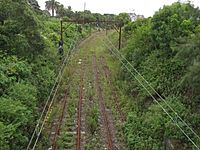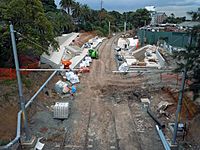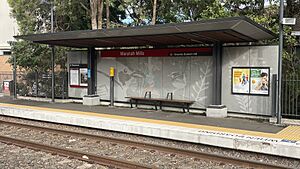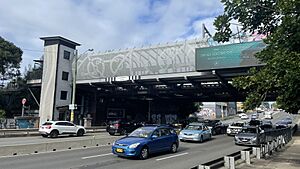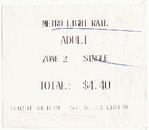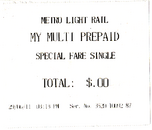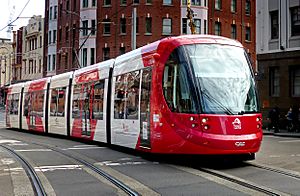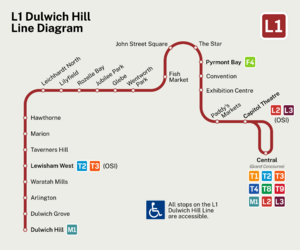Inner West Light Rail facts for kids
Quick facts for kids Inner West Light Rail |
|
|---|---|
 |
|
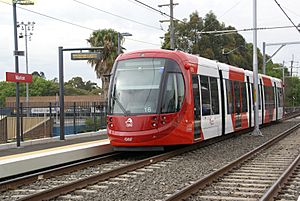
Urbos 3 at Marion in 2014
|
|
| Overview | |
| Status | Fully operational |
| Owner | Transport for NSW |
| Termini | Central Grand Concourse Dulwich Hill |
| Stations | 23 |
| Service | |
| Services | L1 Dulwich Hill Line |
| Operator(s) | Transdev Sydney |
| Depot(s) | Pyrmont |
| Rolling stock |
|
| Ridership | 10.3 million (2017–18) |
| History | |
| Opened |
|
| Technical | |
| Track length | 12.8 km (8.0 mi) |
| Track gauge | 1,435 mm (4 ft 8 1⁄2 in) standard gauge |
| Electrification | 750 V DC from overhead catenary |
The Inner West Light Rail is a special train line in Sydney, Australia. It is 12.8-kilometre (8.0 mi) long and connects Central Station to Dulwich Hill. Along the way, it stops at 23 different places. This line was the first part of Sydney's modern light rail system. Since 2014, it has been known as the L1 Dulwich Hill Line.
Most of the Inner West Light Rail follows an old railway path that used to carry goods. The first part of the light rail opened in 1997. Later, it was made longer in 2000 and again in 2014.
The New South Wales Government's transport group, Transport for NSW, owns the line. A company called Transdev Sydney runs the trains and keeps them in good shape.
Contents
History of the Inner West Light Rail
How the Line Started
Most of the L1 Dulwich Hill Line was once a railway line for carrying goods. This old line was called the Rozelle–Darling Harbour Goods Line. Back in 1848, the Sydney Railway Company planned to build a freight station at Darling Harbour.
So, a railway line was built between Sydney's main station (now Central Station) and Darling Harbour. It opened on 26 September 1855. This line was later extended to Dulwich Hill in 1922. It went through tunnels like the John Street tunnel and the Glebe tunnel, and passed by Lilyfield. There was also a short branch line from Lilyfield to Rozelle for another freight station.
For many years in the early 1900s, this line was very busy with freight. But as containers became popular and new freight stations opened in places like Port Botany, less cargo went to Darling Harbour. The port eventually closed, and the area was rebuilt in the 1980s.
Building the Light Rail
Work to turn the old railway line into a light rail began on 25 January 1996. The first section, from Central Station to Wentworth Park, took 16 months to build. This 3.6-kilometre (2.2 mi) section used the old Darling Harbour goods line. It also used a tram loop at Central Station that was part of Sydney's old tram network. A new section of track was built along Hay Street to connect them.
The first light rail services started on 11 August 1997. They ran from 9 AM to 5 PM after three weeks of testing. The official opening was on 31 August 1997, led by the State Premier, Bob Carr.
Because the first line was a success, it was extended. A 3.6-kilometre (2.2 mi) extension with four new stops opened on 13 August 2000. This extension took the light rail to Lilyfield, which was the end of the closed goods line.
Extending to Dulwich Hill
In 2009, freight trains stopped using the line between Rozelle and Dulwich Hill. In February 2010, the government announced plans to extend the light rail. This new section would be 5.6-kilometre (3.5 mi) long, going from Lilyfield to Dulwich Hill.
Work to upgrade the tracks began in August 2010. The project was approved in February 2011. It was first planned to open in 2012. However, in September 2011, the new government said it would not open until 2014. The cost also went up from $120 million to $176 million.
A walking and cycling path called the Greenway was supposed to run next to the light rail. But this part of the project was put on hold. The government said the delays and extra costs were due to rushed planning by the previous government.
The Greenway project was restarted in 2016 with money from the national government. Construction is still ongoing, with a big new link under Parramatta Road starting in late 2023.
A company called John Holland Group was chosen on 31 May 2012 to build the new stops, bridges, and power systems. The extension to Dulwich Hill finally opened on 27 March 2014.
Connecting to Other Light Rail Lines
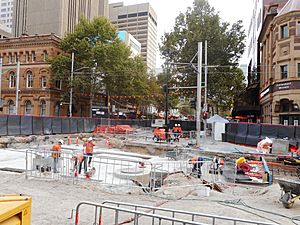
In January 2017, the line was closed between Central and Convention stops. This was for construction work at the George and Hay Street intersection. This work was part of the CBD and South East Light Rail project. Another closure happened in January 2018 to add a connection between the two light rail lines. This connection allows trams from the CBD and South East line to reach the maintenance area at Lilyfield.
How the Light Rail is Run
When the line first opened in 1997, it was owned by the Sydney Light Rail Company (SLRC). This company had a 30-year agreement to run the light rail until 2028. After that, the New South Wales Government would take over ownership. The first company to operate the services was TNT Transit Systems.
Over the years, different companies became involved in running the light rail. Eventually, in March 2012, the New South Wales Government bought Metro Transport Sydney, which owned the line. However, Transdev continued to operate the services.
In 2014, a group called ALTRAC Light Rail (which includes Transdev) won a new contract. This contract meant Transdev would keep running the Dulwich Hill Line until 2034.
Tickets and Fares
When the light rail first opened, it had its own paper tickets. You could buy tickets from machines at each stop. Later, conductors started selling tickets on board.
Over time, the light rail system became more connected with other public transport in Sydney. From June 2011, you could use MyMulti tickets, which worked on trains, buses, and ferries, on the light rail too. This made it much easier for people to travel, and more people started using the light rail.
The Opal ticketing system, which uses smartcards, was introduced on the line on 1 December 2014. After Opal was introduced, even more people used the light rail. Most paper tickets were stopped in 2016, and now you mainly use Opal cards or Opal single trip tickets.
Naming the Line
At first, the Dulwich Hill Line was just called the Sydney Light Rail. Later, it was called Metro Light Rail. After the New South Wales Government bought the system, it was renamed the Inner West Light Rail. Since the extension to Dulwich Hill opened in 2014, it's often called the Dulwich Hill Line. It was also given the number L1, just like other train and ferry routes in Sydney.
How Many People Ride the Light Rail?
In 1998, about 5,000 people rode the light rail on weekdays. This number grew a lot over the years.
- In 2009–10, there were 2.8 million trips.
- In 2012–13, it increased to 4.2 million trips.
- In 2014–15, after the Dulwich Hill extension opened, it jumped to 6.1 million trips.
- From 2015 to 2016, 9.7 million trips were made.
- In 2016–2017, it was 9.1 million trips.
The increase in ridership was partly because of better ticket options and the new extensions. Sometimes, the numbers were lower due to closures for maintenance or construction.
|
L1
|
4 721 000 | |
|
L2
|
6 025 000 | |
|
L3
|
6 236 000 |
Incidents and Repairs
The line ran smoothly until 7 October 2013, when two trams went off the tracks within 20 minutes. This is called a derailment. It was thought that new tracks installed in September might have damaged the wheels of the trams. All services were stopped and replaced by buses. Services slowly returned to normal over the next few weeks. One tram was so damaged it had to be scrapped.
After these incidents, trams had to slow down to 25 km/h (16 mph) at certain points where tracks crossed. In 2020, the government said they were looking into removing some of these crossings. This would allow trams to go faster and carry more passengers. They were also thinking about buying four new trams to run services more often.
Limits on More Services
In August 2017, a government report showed that more people were using the light rail than expected. However, it was hard to add more services during busy times, which run every eight minutes. This is because of several reasons:
- There's only one track at the Dulwich Hill end.
- There isn't enough space to store more trams.
- The power supply, signals, and maintenance areas have limits.
- There aren't enough trams in the fleet.
The report suggested that shuttle services between Central and Lilyfield could help. More homes are being built along the line, so even more people are expected to use it. Some stops, like Leichhardt North and Dulwich Hill, have longer platforms. This means they might be able to handle longer trams in the future.
Service Suspension in 2021–2022
On 28 October 2021, light rail services were stopped. This happened after cracks were found in the welds of some Urbos 3 trams during checks. By 2 November, cracks were found in all 12 Urbos 3 trams. On 5 November, it was announced the line would be closed for up to 18 months for repairs. The cracks were more serious than first thought, and it was called a "design flaw." Buses replaced the light rail services.
To open the line sooner, trams were borrowed from the CBD and South East Light Rail and tested on the Inner West Light Rail. L1 services started again with these borrowed trams on 12 February 2022. Customers using the light rail and replacement buses received a 30 percent discount on their fares while the Urbos 3 trams were being fixed.
Types of Trams Used
The Inner West Light Rail currently uses CAF Urbos 3 and Urbos 100 trams, as well as Alstom Citadis 305 trams. The first Urbos 3 trams started running in July 2014.
When the line first opened, it used seven German-designed Variotrams. These were built in Australia. The last Variotram was removed in May 2015. For a short time, between 2014 and 2015, four leased Urbos 2 trams were also used.
In November 2020, it was announced that four new trams would be bought. These new Urbos 100 trams arrived in August 2023 and started full service on 7 December 2023.
The Light Rail Route
The L1 Dulwich Hill Line has 23 stops and is 12.8 kilometres (8.0 mi) long. About 1.5 kilometres (0.93 mi) of the track runs along streets. Except for Central, Capitol Square, and Paddy's Markets, all stops are on the path of the old railway line.
Since April 2024, L1 services run from 5 AM until 1 AM the next day.
- During busy weekday hours, trams come every 6 minutes.
- Between busy times, they come every 10 minutes.
- At other times, they come every 15 minutes.
- On weekends and public holidays, trams run every 10 minutes for most of the day, and every 15 minutes in the mornings and evenings.
Before April 2024, the light rail ran from 6 AM to 11 PM, and until midnight on Fridays. The new hours match the L2 Randwick and L3 Kingsford lines. Special late-night services between Central and The Star were stopped in 2020 due to the COVID-19 pandemic and have not restarted. <mapframe width="500" height="400" zoom="13" align="center" frameless> [ { "type": "ExternalData", "service": "page", "title": "Inner West Light Rail.map" }, { "type": "ExternalData", "service": "page", "title": "Inner West Light Rail stops.map" } ] </mapframe>
Key Stops Along the Line
The Inner West Light Rail connects many important places. Here are some of the main stops:
Central Grand Concourse
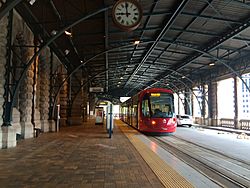 |
Opened |
|---|---|
| 1997 | |
| Transfer | |
| Central railway station, Bus routes and L2 Randwick & L3 Kingsford lines at Central Chalmers Street light rail stop |
|
| Location | |
| 33°52′56″S 151°12′23″E / 33.88222°S 151.20639°E |
The Central Grand Concourse stop is the first stop on the line, located at Central Station. It's on the first floor, above Eddy Avenue. This stop connects to the main waiting area of Central Station.
Trams use a special loop here. They stop at one platform for people to get off, then move to another platform for people to get on. This loop means the driver doesn't have to change ends of the tram. This loop was actually used by Sydney's old tram system until 1957.
At Central, you can easily change to Sydney Trains and NSW TrainLink services. You can also reach the L2 and L3 lines at the nearby Central Chalmers Street stop. Soon, Sydney Metro trains will also stop at Central.
Capitol Square
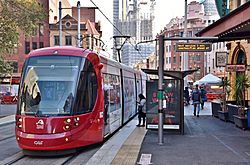 |
Opened |
|---|---|
| 1997 | |
| Transfer | |
| L2 Randwick & L3 Kingsford lines at Chinatown light rail stop | |
| Location | |
| 33°52′47.2″S 151°12′20.2″E / 33.879778°S 151.205611°E |
The Capitol Square stop is across from the Capitol Theatre. This theatre hosts big, popular shows. The stop is on Hay Street, close to George Street. Hay Street is closed to other cars here. The CBD and South East Light Rail runs along George Street, and there's a connection between the two lines here. This connection allows trams from the new line to get to the maintenance area at Lilyfield.
Paddy's Markets
 |
Opened |
|---|---|
| 1997 | |
| Transfer | |
| None | |
| Location | |
| 33°52′45.5″S 151°12′10″E / 33.879306°S 151.20278°E |
The Paddy's Markets stop is outside the famous Paddy's Markets in Haymarket. This area has been redeveloped. The old Sydney Entertainment Centre and Sydney Monorail stop were here, but they have been replaced by new buildings and a public square called Darling Square.
West of this stop, the light rail joins the path of the old freight railway line. Part of this old path has been turned into a walking path called The Goods Line.
The Star
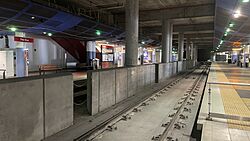 |
Opened |
|---|---|
| 1997 | |
| Transfer | |
| 389 bus route | |
| Location | |
| 33°52′05″S 151°11′43″E / 33.86806°S 151.19528°E |
The Star stop is the main way to get to The Star entertainment complex in Pyrmont. The stop is located under the complex. It also serves nearby offices.
Lilyfield
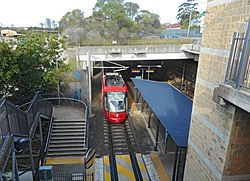 |
Opened |
|---|---|
| 2000 | |
| Transfer | |
| 437 & 470 bus routes | |
| Location | |
| 33°52′27″S 151°09′54″E / 33.87417°S 151.16500°E |
The Lilyfield stop serves a residential area in Lilyfield. It's located in a wide trench under the City West Link road. This stop is the only one on the line with an island platform (a platform with tracks on both sides). You can get to the platform by stairs or a lift from Catherine Street. Lilyfield was the end of the line between 2000 and 2014.
There's a place to store four trams west of the stop. The tracks were changed here when the line was extended to Dulwich Hill.
Dulwich Hill
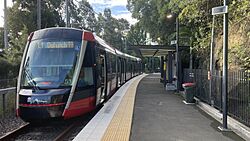 |
Opened |
|---|---|
| 2014 | |
| Transfer | |
| Dulwich Hill railway station & 412 bus route | |
| Location | |
| 33°54′37.73″S 151°8′24.85″E / 33.9104806°S 151.1402361°E |
The Dulwich Hill stop is at the southern end of Dulwich Hill. It's right next to Dulwich Hill railway station on the Bankstown Line. This is the last stop on the light rail line.
The design of this stop was changed to save money and reduce environmental impact. It has a single platform. Even though it's a bit further from the train station than first planned, it has a connection to Jack Shanahan Park, making it easier to access.
Because there's only one track at this end, it limits how often trams can run. In 2017, Transport NSW said they would look into ways to upgrade the line to allow more services. A new entrance to the train station opened in October 2023, with lift access to help people transfer.
Images for kids
-
The Exhibition Centre stop serves the suburb of Ultimo and the Darling Harbour area.
-
The Pyrmont Bay stop is located under an apartment building in Pyrmont.
-
The Wentworth Park stop serves a residential area in Pyrmont.
-
The Glebe stop is located near the shopping area in Glebe.
-
The Rozelle Bay stop serves a residential area in the north of Annandale.
-
The Hawthorne stop is located at the border of Leichhardt and Haberfield.
-
The Lewisham West stop is located on the border of Lewisham and Summer Hill.
-
The Waratah Mills stop serves a residential area in the northern part of Dulwich Hill.


